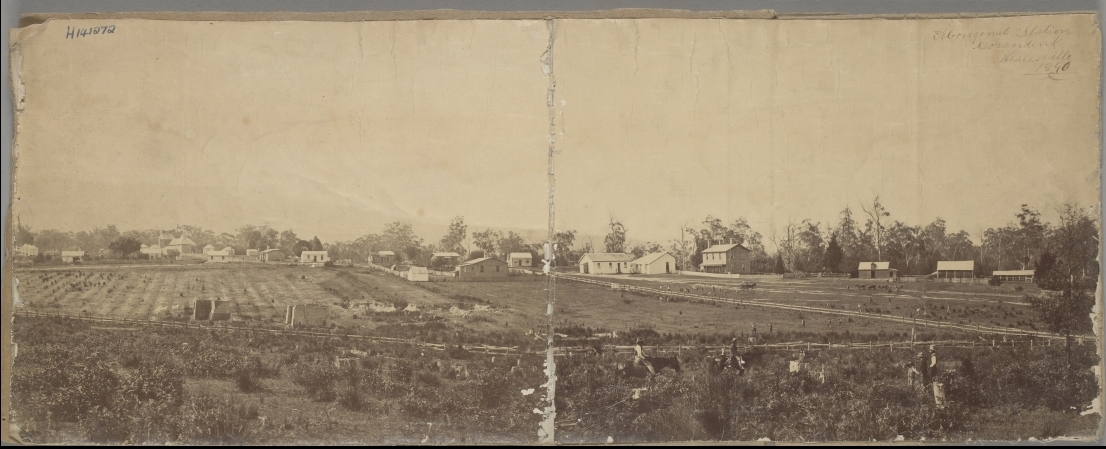Coranderrk Aboriginal Station |

Coranderrk was a Government reserve set up in 1863 for Aboriginal people who had been dispossessed by the arrival of Europeans to the state of Victoria.
The reserve was closed in 1924, with most residents moved to Lake Tyers Mission. Five older people refused to move and continued living there until they died. James Wandin was the last person born at Coranderrk Station, in 1933, in the home of his grandmother, Jemima Wandin.
William Barak (1824 - 1903) the last traditional ngurungaeta (elder) of the Wurundjeri-willam clan is buried here.
The site for Coranderrk Aboriginal Station was selected when 40 Aboriginal people left Mohican station, led by Wonga and Barak from the Wurundjeri clan.
They settled on a site between Badger Creek and Watts River near Healesville in 1863. The original 2,300 acres of picturesque land was gazetted as a Reserve within three months of their move, although at it's largest, Coranderrk included 4,850 acres.
A successful hop farm, the future of Coranderrk was threatened by the resignation of Superintendent John Green, ill health amongst the residents and the selling off of land.
Despite these problems, Coranderrk's operations spanned 80 years and it has been hailed as one of Victoria's most important Aboriginal reserves.
Coranderrk
Cabbe melemung il
(Woi wurrung greeting)
According to Aboriginal tradition We, the First People, have been here since time began.
Our culture is the oldest living culture in the world. No-one knows with certainty how many Aboriginal people were living here when Europeans arrived but it is thought that the region now known as Victoria was able to support approximately 60,000 people.
Traditional Kulin life was a successful civilisation. Victoria was made up of a mosaic of 36 groups which were defined by land, protocols, language. The language of the Wurundjeri is the Woiwurrung. The four neighbouring groups - Boonwurrung, Dja Dja wurrung, Taungurung and Wathaurong - are collectively known as the Kulin Nation. Kulin means man. These groups cover most of central Victoria as we know it today.
Each group had a deep and intimate knowledge of their country and all the resources within it. Foods and resources were made or eaten in accordance with laws set down by ancestors/family ensuring conservation and maintaining an inextricable connection and respect for the country where they belonged.
My ancestors were the ultimate conservationists, they held an intimate connection to the landscape and understood that the everyday actions could affect the world around them.
Being governed by the environment ensured that the landscape would provide and sustain generations to come - no easy feat in a land with an highly irregular rainfall.
Wonga was one of the first Indigenous leaders who tried to regain the land taken by settlers. In 1859, he took a small group of Taungurong men from the Goulburn River to see William Thomas, acting as their interpreter and mediator. In a letter to Redmond Barry, Thomas quotes Wonga:
I bring my friends Goulburn Blacks, they want a block of land in their country where they may sit down plant corn potatoes etc etc, and work like white man.
- Simon Wonga
The Aboriginal people of Victoria were decimated by colonisation. Those who did survive were forced to live on the fringes of society.
From the 1840s Kulin people were trying to find new ways of existence and survival.
The 1860s marked the beginning of the era of reserves and missions. Six Aboriginal reserves were established during the 1860s. These were under the control of the Board for the Protection of Aborigines. Four were Christian missions receiving government aid. These were Lake Tyers (Anglican) and Ramahyuck (Presbyterian/Moravian) in eastern Victoria for the Gunai/Kurnai clans; Ebenezer (Moravian) in north-west Victoria for the clans of the Wimmera and Lower Murray; and Lake Condah (Anglican) in south-west Victoria. The other two were secular government controlled reserves: Framlingham which, like Lake Condah, was established for the Mara-speaking Gunditjmara and Kirrae-wurrung people of south-west Victoria; and Coranderrk, located about 60 kilometres north-east of Melbourne, for the Kulin clans of central Victoria.
In 1863, after a period of devastation to the Kulin people, Coranderrk was established.
❊ Address ❊
℅ Woo-rite
⊜ 19 Barak Lane Healesville 3777 View Map
❊ Web Links ❊
➼ Coranderrk Aboriginal Station
➼ www.abc.net.au
➼ www.wikipedia.org/Coranderrk
➼ www.wikipedia.org/William_Barak
➼ www.coranderrk.com
Disclaimer: Check with the venue (web links) before making plans, travelling or buying tickets.
Accessibility: Contact the venue for accessibility information.
Update Page







